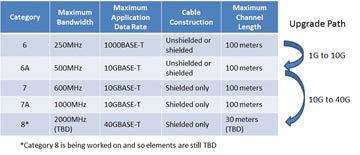Frank Straka, Product Development Manager, Panduit, www.Panduit.com
Recently the IEEE P802.3bq Task Force was formed to create a standard for 40-gigabit Ethernet over copper twisted-pair cabling (40GBASE-T). This is the next generation following 10-gigabit Ethernet over copper twisted-pair cabling (10GBASE-T). The BASE-T families of standards are regarded as one of the most successful and deployed Ethernet standards in the world today. They feature cost advantages and ease of deployment with auto-negotiation and the ubiquitous RJ45 connector for seamless backward compatibility. The IEEE is the main standards body for BASE-T, focusing on both the equipment and cabling. In support of the development of 40GBASE-T, the cabling standards bodies (TIA and ISO/IEC) have also been working hard on creating Category 8 cabling and connector specifications.
There is a distinct tradeoff between the cabling specifications and the equipment specifications. Cables that are easier to design and manufacture tend to have worse performance, requiring more advanced equipment, while more advanced and harder to manufacture cables will likely have better performance, requiring less advanced equipment. The goal of the standards body is to come together and try to find the optimum tradeoffs between these elements to optimize the time to market and power consumption for the user and maintain a broad market potential.
Collaboration required
40GBASE-T is a great example where both the equipment vendors and cabling vendors are working together to try and find the optimum scenario. Cabling vendors, such as Panduit, want to ensure that our customers continue to enjoy the advantages of BASE-T standards. We need to ensure that the cable specification has sufficient reach and usability so it can be used in as many scenarios as possible.
While there are no official standards yet developed, it is clear that 40GBASE-T will require the most advanced twisted-pair cabling technology yet. It will require a bandwidth of between 1,500 to 2,000 MHz. As a point of reference, 10GBASE-T only requires Category 6A/Class EA components with a bandwidth of 500 MHz. Even the European ISO/IEC standards for Category 7A/Class FA only have a bandwidth of 1,000 MHz. The difference in magnitudes can be seen in Fig. 1 .

Fig. 1: Existing cabling standards versus 40GBASE-T (Category 8).
Another change with 40GBASE-T over traditional BASE-T standards is that the channel length had to be reduced from 100 meters to 30 meters in order to reduce power consumption and equipment complexity. (“Channel” is the term for the combination of cables and connectors.) All prior Categories and BASE-T Ethernet standards allowed for lengths of up to 100 m. In order to properly service as broad a market as possible, companies worked to ensure the maximum channel length was at least 30 meters — designed to support both end of row and top of rack topologies and provide data center customers with maximum flexibility. While this length can change since there is no standard published, at this point 30 m is assumed to be the likely maximum cable length (see Fig. 2 ).

Fig. 2: Maximum lengths compared.
Available next year
What this highlights is that there are no existing cabling standards that are close to meeting the needs for 40GBASE-T. Cabling companies have been working hard to develop new Category 8 cables and connectors. There has been much progress from a multitude of cabling vendors like Panduit showing connectors and cabling with 2,000 MHz bandwidths (see Fig. 3 ).
It is expected that products will be available in late 2014 to early 2015 when the standards become more developed. At this point the standards are in a state of constant flux so it is still too early to supply products.

Fig. 3: Category 8 prototype test results.
Table 1 highlights the different categories of cables and the applications they are designed to support, as well as the upgrade path through the different data rates. 1000BASE-T will run on Category 6, 10GBASE-T will run on Category 6A, and 40GBASE-T will run on the yet to be fully defined Category 8. There are no specific Ethernet applications for Category 7 or Category 7A. Since 40GBASE-T standards are in state of flux and no existing standards come close to meeting these requirements, it is recommended that today if someone is looking to install 10GBASE-T that they use Category 6A cabling and connectors.

Table 1: Category cable standards overview with supported data rates and upgrade path
40GBASE-T is becoming an excellent example of different industries collaborating together in order to provide our customers with the optimum products with the fastest time to market. Cabling companies like Panduit are working hard and doing our part to design next-generation cabling and connectors so that 40GBASE-T becomes another successful member of the BASE-T Ethernet family.
Currently, the state of the art for twisted-pair copper cabling is running 10GBASE-T over Category 6A cabling. The Panduit MaTriX Category 6A solution, including the PUP6A04BU-UG cable with CJ6X88TG-style jacks, is an example of an available Cat 6A system good for lengths up to 100 m with a bandwidth of 500 MHz.
Advertisement
Learn more about Panduit





